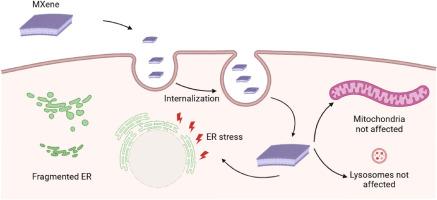Understanding the role of polyethylene glycol coating in reducing the subcellular toxicity of MXene nanoparticles using a large multimodal model
IF 10.2
1区 医学
Q1 ENGINEERING, BIOMEDICAL
引用次数: 0
Abstract
MXenes exhibit remarkable properties such as high electrical conductivity, mechanical strength, and versatile surface chemistry, positioning them as promising candidates for various applications in energy storage, biomedical engineering, and environmental remediation. However, concerns regarding their potential toxicity necessitate a deeper understanding of their interactions with biological systems. This study investigates the subcellular interactions of MXenes, focusing on the mitochondria, endoplasmic reticulum (ER), and lysosomes. Using structured illumination microscopy (SIM), the observations reveal that MXenes exhibit selective toxicity, primarily causing structural damage to the ER, while leaving mitochondria and lysosomes largely unaffected. This organelle-specific toxicity appears to be linked to the negative surface charge of MXenes, which modulates their interactions with cellular components. Notably, surface modification of MXenes with polyethylene glycol (PEG) significantly reduces ER toxicity, thereby improving biocompatibility and offering a promising strategy for safer biomedical applications. Building on these findings, it also introduces a novel methodology that employs a large multimodal model (LMM), a state-of-the-art artificial intelligence (AI) framework, for the automated analysis and interpretation of super-resolution microscopy images.

利用大型多模态模型了解聚乙二醇涂层在降低MXene纳米颗粒亚细胞毒性中的作用
MXenes具有卓越的性能,如高导电性、机械强度和多用途表面化学,使其成为储能、生物医学工程和环境修复等各种应用的有希望的候选者。然而,考虑到它们的潜在毒性,需要更深入地了解它们与生物系统的相互作用。本研究探讨了MXenes的亚细胞相互作用,重点是线粒体、内质网(ER)和溶酶体。使用结构照明显微镜(SIM),观察结果显示MXenes表现出选择性毒性,主要引起内质网结构损伤,而线粒体和溶酶体基本不受影响。这种细胞器特异性毒性似乎与MXenes的负表面电荷有关,负表面电荷调节了它们与细胞成分的相互作用。值得注意的是,用聚乙二醇(PEG)修饰MXenes的表面可以显著降低内质网毒性,从而提高生物相容性,为更安全的生物医学应用提供了一种有前景的策略。在这些发现的基础上,它还介绍了一种采用大型多模态模型(LMM)的新方法,这是一种最先进的人工智能(AI)框架,用于超分辨率显微镜图像的自动分析和解释。
本文章由计算机程序翻译,如有差异,请以英文原文为准。
求助全文
约1分钟内获得全文
求助全文
来源期刊

Materials Today Bio
Multiple-
CiteScore
8.30
自引率
4.90%
发文量
303
审稿时长
30 days
期刊介绍:
Materials Today Bio is a multidisciplinary journal that specializes in the intersection between biology and materials science, chemistry, physics, engineering, and medicine. It covers various aspects such as the design and assembly of new structures, their interaction with biological systems, functionalization, bioimaging, therapies, and diagnostics in healthcare. The journal aims to showcase the most significant advancements and discoveries in this field. As part of the Materials Today family, Materials Today Bio provides rigorous peer review, quick decision-making, and high visibility for authors. It is indexed in Scopus, PubMed Central, Emerging Sources, Citation Index (ESCI), and Directory of Open Access Journals (DOAJ).
 求助内容:
求助内容: 应助结果提醒方式:
应助结果提醒方式:


